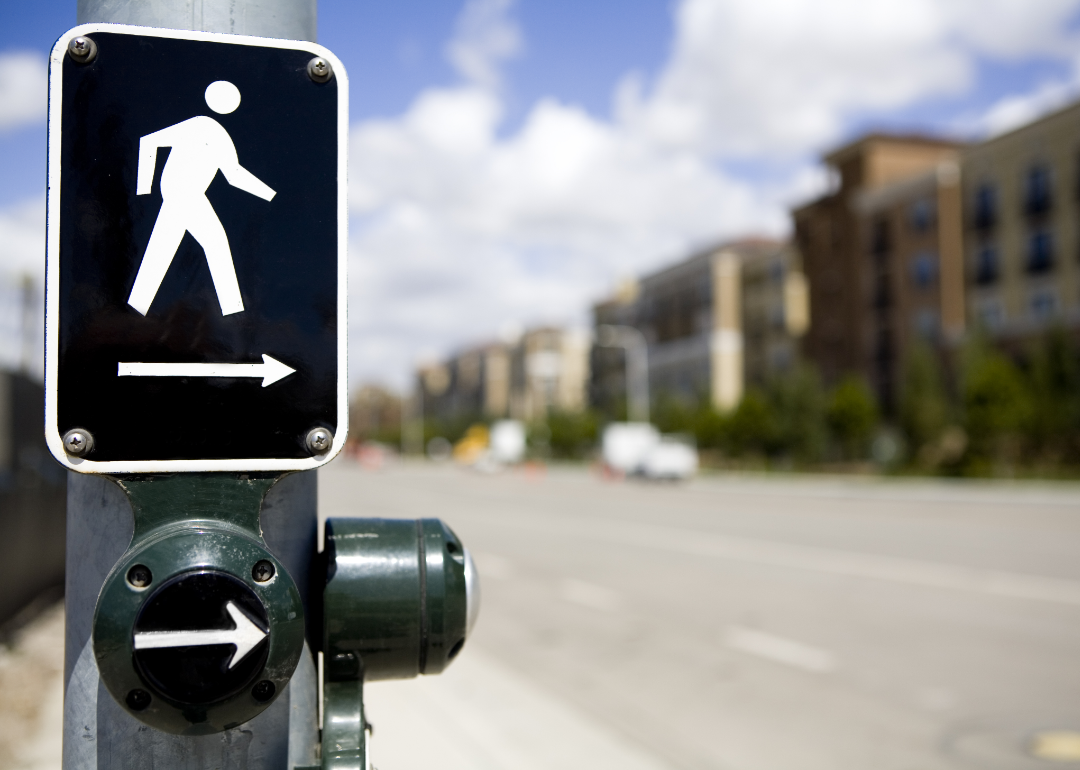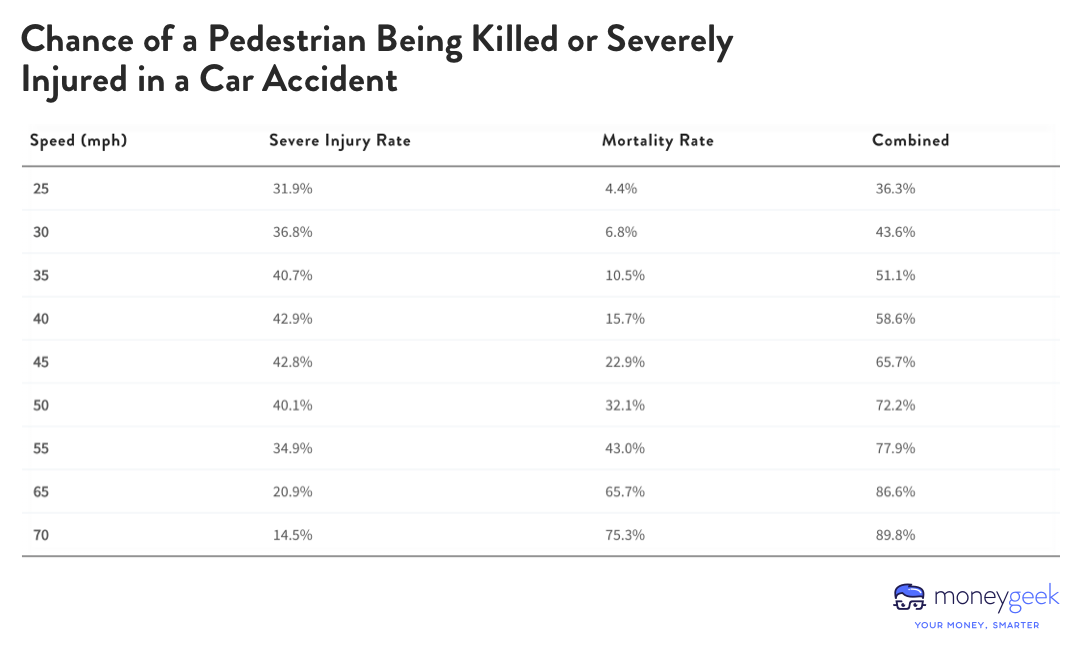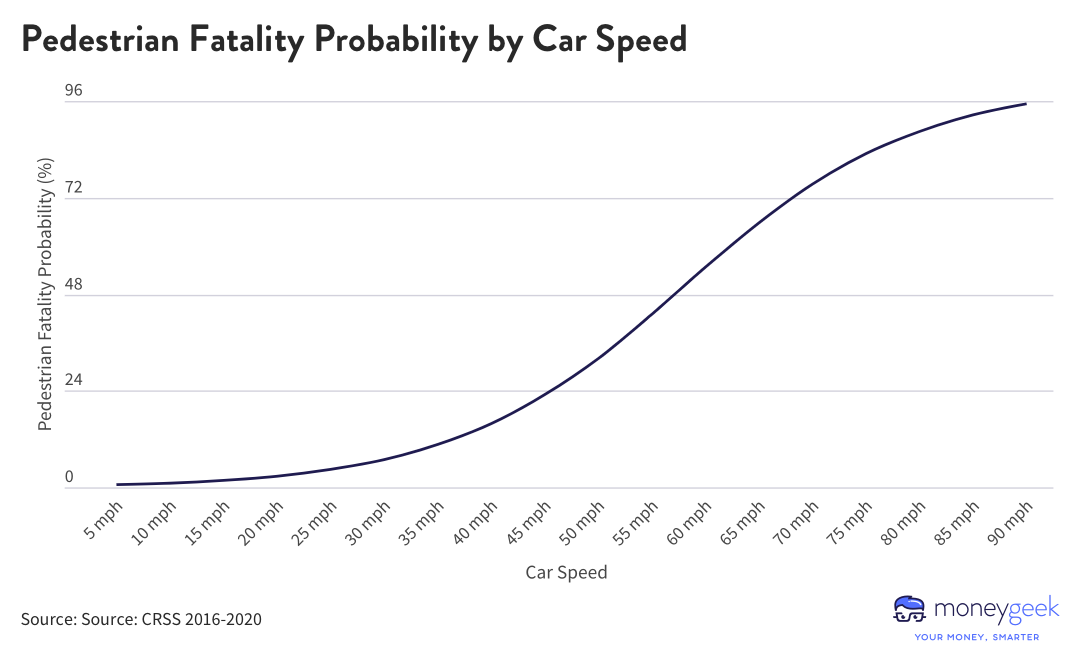Pedestrian crash analysis shows that even at low speeds, accidents often cause severe injuries

Canva
Pedestrian crash analysis shows that even at low speeds, accidents often cause severe injuries
A lit pedestrian crosswalk sign on a road.
Every year an estimated 70,000 pedestrians are hit by vehicles in the United States. But contrary to popular belief, car accidents involving pedestrians don’t always result in deaths — many result in severe injury. For example, 6.8% of pedestrians hit by a car traveling 30 mph die, but 37% experience severe injury.
Given these possible outcomes, MoneyGeek analyzed pedestrian crash data from the National Highway Traffic Safety Administration (NHTSA) to help keep pedestrians and motorists safe on the road while highlighting the importance of auto insurance in a crash. Here’s what the study found.
Key findings
The study analyzed NHSTA data from 2015 to 2020 — the most recent years available — to learn more about the outcomes of pedestrian crashes.
- 9.1% of pedestrians hit by vehicles die, and 21.8% are severely injured.
- It doesn’t take high speeds to severely injure — or kill — pedestrians. 1 in 3 pedestrians hit by vehicles traveling 25 mph are severely injured, and 1 in 10 pedestrians hit at 35 mph die.
- Getting hit by a Cadillac Escalade, Ford F-150, Dodge Caravan or other pickup truck, SUV or minivan increases pedestrian mortality rates by 54% at 25 mph compared to rates for sedans.
- Over 70,000 pedestrians are hit by vehicles annually in the U.S.
- The mortality rate is four times higher for pedestrians hit somewhere other than an intersection. The typically slower speed of vehicles at intersections increases pedestrians’ chances of survival.
- Every 10 mph of increased speed driven doubles pedestrian mortality rates. At lower speeds, the rate is even higher. For example, from 25 to 35 mph, the mortality rate increases from 4.4% to 10.5%.
![]()

MoneyGeek
Chances of severe injury are high, even when driving at slow speeds
A chart showing various speeds and the chances of a pedestrian being severely injured or killed when hit by a car going that speed.
Although most pedestrians survive a vehicle impact thanks to modern medicine, the rate of severe injury from car accidents is high, and these injuries can be life-altering. Even at a pedestrian accident speed of 25 mph, the study found a 31.9% chance of serious injury.
The U.S. Department of Transportation (DOT) defines a serious injury as any harm that is not fatal and results in one or more of the following:
- Severe laceration with exposure of underlying tissue, muscle or organs, or causing significant blood loss
- Broken or distorted arms or legs
- Compression of body parts
- Possible skull, chest or abdominal injury
- Second- or third-degree burns that cover 10% or more of the body
Leaving the accident scene in a state of unconsciousness - Paralysis
As the table illustrates, the chances of severe injury or fatalities increase with increased speed. However, even those driving slowly — think 25 to 30 mph — still have about a 1 in 3 chance of severely injuring pedestrians in an accident. This risk underscores the importance of safe driving in the places we might take it most for granted, like school zones, neighborhoods and parking lots.
Crashes at intersections are common but not as deadly
The analysis found that 48% of pedestrians were hit at intersections, and 49% of all intersection impacts occurred when vehicle speeds were between 0 and 10 mph.
Data shows that only 4% of these accidents result in death, versus the 18.4% mortality rate of pedestrians hit in other areas. Low mortality rates at intersections are likely related to the slow speed of vehicles there.
Although accidents at intersections are unlikely to kill pedestrians, it’s important to remember that even low-speed crashes can result in severe injury.
Since the chance of being hit by a car is greater at intersections, it’s important for pedestrians to avoid jaywalking and choose crosswalks instead.
By the same token, drivers must take extra precautions and keep these statistics in mind when approaching an intersection. Because accidents do happen, it’s essential for drivers to have proper liability car insurance coverage for their protection and the well-being of everyone on the road. While minimum requirements vary from state to state, insufficient coverage can leave drivers with thousands of dollars in out-of-pocket expenses, lost-income lawsuits or even bankruptcy.

MoneyGeek
Commercial vehicles are deadliest, but even sedans can kill
A table listing various speeds and vehicle types, where a pedestrian hit by a larger vehicle is more likely to die than one hit by a smaller vehicle, regardless of the speed the vehicle is moving.
The study utilized logistic regression to analyze the effect of different variables on the outcome of a crash that involved a vehicle and a pedestrian — including vehicle body types.
The analysis showed that larger vehicles and commercial vehicles with special licensing requirements are the deadliest. When driven at a speed of 45 mph, the chance of being killed by a bus, semi-truck or other heavy vehicle is 42.1%.
In contrast, at an everyday speed of 30 mph, popular family automobiles such as SUVs, pickup trucks and minivans have a crash mortality rate of 10.4%; a sedan driving at the same speed has a mortality rate of 6.8%. While accidents involving these vehicles are comparatively less deadly to pedestrians than larger commercial vehicles, they can still result in deaths at pretty low speeds.
This data serves as a further reminder that drivers must stay alert and aware, even during casual trips to the grocery store or kids’ soccer practice — especially in neighborhoods and areas with a lot of foot traffic. When choosing where to walk or go on a run, pedestrians would do well to take note of the types of vehicles that frequent those roads.

MoneyGeek
Speeding still kills
A line chart where the probability of a pedestrian dying when hit by a car increases with the speed the car is moving.
The analysis found a direct correlation between vehicle speed and pedestrian mortality rate. While getting hit by a car going 15 mph only carries a 1.8% chance of death, getting hit by a car going 70 mph increases the mortality rate to 75.3%.
Most people know that driving at high speeds is dangerous, but even they may be surprised that relatively average speeds can result in pedestrian deaths.
At 40 mph, what percentage of pedestrians survive? According to the study, 84.3%. While the chance of survival sounds high, it’s important to keep in mind that the severe injury rate at this speed is 42.9%, for a combined acute injury and fatality rate of 58.6%.
What drivers and pedestrians can do to make our roads safer
Despite the likelihood that most pedestrians struck by vehicles will survive, fatal accidents can and do happen. Indeed, the Governors Highway Safety Association estimated that, in 2021, 7,485 pedestrians were killed in crashes involving vehicles across cities in the U.S. — an average of 20 fatalities per day.
Drivers and pedestrians all have a responsibility to keep our roads safe: this is a simple concept, but one that makes the roads safer for everyone involved. The following are some suggestions on what drivers and pedestrians can do to keep roads safe and ultimately prevent accidents:
Driver safety tips
- Follow the speed limit and obey traffic signals.
- Stay off your phone while driving, even at lights and stop signs.
- Avoid distractions, such as the radio or emotional conversations.
- Never drive under the influence of alcohol or drugs.
- Give pedestrians the right of way.
- Make sure you have proper visibility, especially when driving at night.
- Examine your surroundings before backing up.
- Don’t pass stopped school buses.
- Discuss teen driver safety and their responsibilities behind the wheel.
- Prepare yourself to drive in winter weather conditions.
- Always have proper auto insurance coverage.
Pedestrian safety tips
- Enhance your visibility with bright colors, especially when walking or jogging at night.
- Avoid jaywalking.
- Make eye contact with drivers when you’re ready to cross an intersection.
- Don’t walk and text.
- Avoid talking on the phone while walking.
- Pay attention to your surroundings.
- Be sure to look out for electric vehicles with quiet engines.
- Obey traffic signals.
- Look both ways before crossing the street.
- Talk to children about pedestrian safety.
For increased safety on the road, the California Department of Motor Vehicles issued a safe driver checklist that can help motorists prepare before and during their journey. Keeping in mind that accidents happen from time to time, it’s important to also know how to handle the aftermath of a car accident and stay safe after a crash.

MoneyGeek
Methodology
A chart listing several variables and other statistical data about the study’s methodology.
The study reviewed 3,429 instances where pedestrians were hit by vehicles as reported in the NHTSA’s Crash Report Sampling System (CRSS) from 2016 to 2020, the latest five years of data available.
To develop mortality rate curves, the study utilized a logistic regression fit to 3,429 events where the dependent variable was whether the pedestrian died or not. Independent variables for the model were vehicle speed, pedestrian age, a flag for light trucks (inclusive of SUVs and minivans) and a flag for heavy vehicles.
The model was found to be statistically significant using the log-likelihood ratio test. The coefficients of the independent variables were found to be statistically significant as follows.
Additionally, the study developed a regression model with the dependent variable being a binary flag for either severe injury or fatality.
The results of these models were then used to produce fatality probability estimates for different speeds, ages and body types.
All pedestrian fatality rates assume a 40-year-old pedestrian.
This story was produced by MoneyGeek and reviewed and distributed by Stacker Media.





